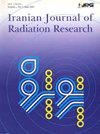剂量网格分辨率对强度调制放射治疗和体积调制电弧治疗患者特异性质量保证结果的影响
Q4 Health Professions
引用次数: 4
摘要
背景:本研究旨在研究参考剂量计算网格大小(RDCGS)对伽马通过率(GPR)的影响,以确保强度调制放射治疗(IMRT)和体积调制电弧治疗(VMAT)的患者特异性质量。材料与方法:回顾性选择20例患者。为每位患者生成IMRT和VMAT计划。伽马分析的参考剂量分布是用1–5 mm的RDCGS以1 mm的间隔计算的。剂量分布是使用MapCHECK2和ArcCHECK剂量计测量的。采用各种RDCGS进行全局和局部伽马分析,伽马标准分别为3%/3 mm、2%/3 mm、2%/2 mm和2%/1 mm。结果:当RDCGS从1mm增加到5mm时,使用MapCHECK2和ArcCHECK的VMAT的2%/2mm的平均全局GPR分别下降了9.3%和5.9%。平均局部GPR分别下降了14%和11.7%。对于IMRT,全局GPRs分别下降4.8%和6%,而局部GPRs则分别下降10.5%和8.6%。当进行局部伽马分析以及应用小距离协议(DTA)时,RDCGS对GPRs的影响变得更大。随着RDCGS的增加,无论放射治疗、探测器或伽马分析的类型如何,每毫米DTA变化的GPR平均变化都会增加。结论:为了准确验证IMRT和VMAT计划,建议必须使用尽可能小的RDCGS来计算参考剂量分布。本文章由计算机程序翻译,如有差异,请以英文原文为准。
Effect of dose grid resolution on the results of patient-specific quality assurance for intensity-modulated radiation therapy and volumetric modulated arc therapy
Background: This study aims to investigate the effect of reference dose calculation grid size (RDCGS) on gamma passing rate (GPR) for patient-specific quality assurance of intensity-modulated radiation therapy (IMRT) and volumetric modulated arc therapy (VMAT). Materials and Methods: A total of 20 patients were retrospectively selected. Both IMRT and VMAT plans were generated for each patient. Reference dose distributions for gamma analysis were calculated with RDCGS of 1–5 mm at intervals of 1 mm. Dose distributions were measured using MapCHECK2 and ArcCHECK dosimeters. Both global and local gamma analyses with gamma criteria of 3%/3 mm, 2%/3 mm, 2%/2 mm, and 2%/1 mm were performed with various RDCGS. Results: As the RDCGS increased from 1 mm to 5 mm, the average global GPRs with 2%/2 mm for VMAT with MapCHECK2 and ArcCHECK decreased by 9.3% and 5.9%, respectively. The average local GPRs decreased by 14% and 11.7%, respectively. For IMRT, the global GPRs decreased by 4.8% and 6%, respectively, whereas the local GPRs decreased by 10.5% and 8.6%, respectively. The effect of the RDCGS on the GPRs became larger when performing local gamma analysis as well as when applying small distance-toagreement (DTA). As the RDCGS increased, the average changes in the GPR per mm of DTA change increased regardless of the type of radiotherapy, detector, or gamma analysis. Conclusion: For an accurate verification of the IMRT and VMAT plans, it is recommended that the reference dose distribution must be calculated with the smallest possible RDCGS.
求助全文
通过发布文献求助,成功后即可免费获取论文全文。
去求助
来源期刊

Iranian Journal of Radiation Research
RADIOLOGY, NUCLEAR MEDICINE & MEDICAL IMAGING-
CiteScore
0.67
自引率
0.00%
发文量
0
审稿时长
>12 weeks
期刊介绍:
Iranian Journal of Radiation Research (IJRR) publishes original scientific research and clinical investigations related to radiation oncology, radiation biology, and Medical and health physics. The clinical studies submitted for publication include experimental studies of combined modality treatment, especially chemoradiotherapy approaches, and relevant innovations in hyperthermia, brachytherapy, high LET irradiation, nuclear medicine, dosimetry, tumor imaging, radiation treatment planning, radiosensitizers, and radioprotectors. All manuscripts must pass stringent peer-review and only papers that are rated of high scientific quality are accepted.
 求助内容:
求助内容: 应助结果提醒方式:
应助结果提醒方式:


